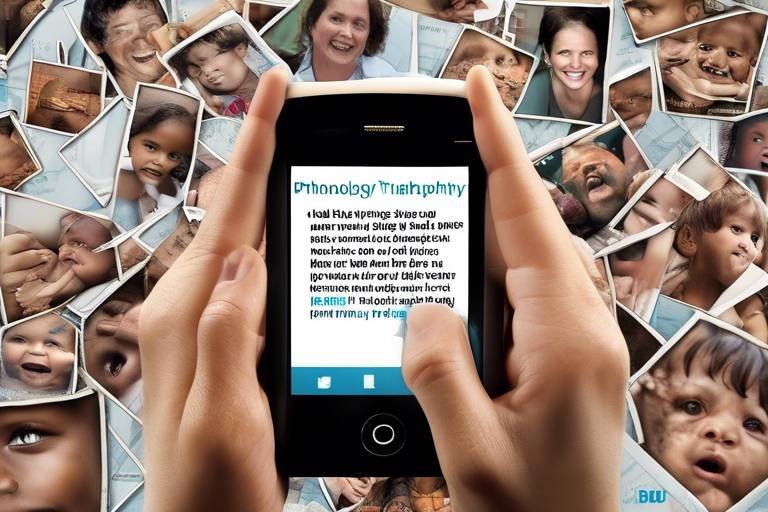How Technology is Transforming Philanthropy
The world of philanthropy is undergoing a remarkable transformation, largely driven by the rapid advancement of technology. Gone are the days when charitable giving was limited to traditional methods like checks and cash donations. Today, technology is reshaping how we think about giving, making it more accessible, efficient, and impactful. Imagine a world where a simple click can connect you to causes you care about, where your donations can be tracked in real-time, and where social media can amplify your voice and reach. This is not just a dream; it's the reality we live in now, and it's changing the landscape of philanthropy forever.
With the rise of online giving platforms, anyone with an internet connection can become a philanthropist. These platforms are designed to facilitate seamless transactions, allowing donors to contribute to their favorite causes from anywhere in the world. This shift has not only increased the volume of donations but has also enhanced engagement and transparency in charitable giving. Donors can now see exactly how their contributions are making a difference, fostering a deeper connection between them and the organizations they support.
Moreover, social media has emerged as a powerhouse for fundraising efforts. Charities can now reach broader audiences and share compelling stories that resonate with potential donors. It’s like having a megaphone that broadcasts your message to millions, inviting them to join your cause. Think about it: when was the last time you scrolled through your feed and didn’t come across a fundraising initiative? Social media encourages community engagement and peer-to-peer fundraising, allowing individuals to rally their friends and family around a cause, thereby amplifying the impact of their efforts.
But it doesn't stop there. The collaboration between nonprofits and influencers has opened up new avenues for fundraising. By partnering with influencers who share similar values, organizations can tap into their extensive networks and credibility, reaching audiences that may not have been accessible otherwise. These partnerships create authentic connections between causes and potential supporters, making the act of giving feel more personal and relatable.
As we delve deeper into this digital revolution, it's essential to recognize the role of data analytics in philanthropy. Understanding donor behavior and preferences is crucial for organizations looking to tailor their outreach strategies effectively. By leveraging data, nonprofits can make informed decisions that enhance fundraising outcomes, ensuring that every campaign is optimized for success. It's like having a roadmap that guides you through the complex landscape of charitable giving, helping you navigate toward your goals.
Additionally, the advent of blockchain technology is revolutionizing transparency in charitable donations. Imagine being able to track your contributions every step of the way, knowing exactly how your money is being utilized. Blockchain offers this unprecedented level of transparency, fostering trust between organizations and their supporters. Donors can feel confident that their contributions are making a real difference and that funds are being used as intended.
Furthermore, smart contracts are paving the way for automation in charitable giving. These digital contracts can enforce agreements and ensure that funds are disbursed according to predetermined criteria, significantly reducing administrative costs and enhancing efficiency. It's akin to having a reliable assistant that handles the logistics, allowing organizations to focus on their mission rather than getting bogged down by paperwork.
However, as with any technological advancement, there are challenges to consider. The integration of technology in philanthropy does not come without its hurdles. Issues such as the digital divide and cybersecurity threats pose significant risks that organizations must address to protect donor information and ensure equitable access to giving opportunities. It's a delicate balance, but one that must be navigated to fully harness the potential of technology in philanthropy.
- How has technology changed the way we give? Technology has made giving more accessible, efficient, and transparent, allowing donors to track their contributions and engage with causes they care about.
- What role does social media play in fundraising? Social media enables charities to reach wider audiences and fosters community engagement through peer-to-peer fundraising initiatives.
- How can influencers impact charitable giving? Collaborating with influencers can amplify fundraising efforts by reaching new audiences and creating authentic connections between causes and supporters.
- What is blockchain technology's role in philanthropy? Blockchain provides transparency in charitable donations, allowing donors to track their contributions and ensuring funds are used as intended.
- What challenges does technology present in philanthropy? Challenges include the digital divide and cybersecurity threats, which organizations must address to protect donor information and ensure equitable access.

The Rise of Online Giving Platforms
In recent years, online giving platforms have emerged as a game-changer in the world of philanthropy, transforming the way donations are made and received. Imagine a world where a donor can contribute to their favorite charity from the comfort of their couch, all with just a few clicks. This convenience has not only made charitable giving more accessible but has also significantly broadened the reach of organizations looking to make a difference. With platforms like GoFundMe, JustGiving, and Kickstarter, the barriers to entry for both donors and nonprofits have been dramatically lowered.
One of the most compelling aspects of online giving platforms is their ability to facilitate seamless transactions. Gone are the days when donors had to write checks or attend fundraising events to show their support. Now, they can easily donate via credit card, PayPal, or even cryptocurrency. This ease of use has led to a surge in donations, especially among younger generations who are accustomed to digital transactions in their everyday lives. According to recent statistics, online donations have increased by over 20% in the past year alone, a clear indicator that people are embracing this new way of giving.
Moreover, these platforms have enhanced engagement and transparency in charitable giving. Donors can track their contributions and see exactly how their money is being used, which fosters a sense of trust and accountability. Many platforms also provide detailed reports and updates on the impact of donations, allowing supporters to feel more connected to the causes they care about. This transparency is crucial, especially in a world where skepticism about charitable organizations can often lead to hesitancy in giving.
Additionally, online giving platforms have made it easier for nonprofits to reach a global audience. With just a click of a button, a small charity in a remote village can attract donations from individuals across the globe. This democratization of giving means that even the smallest organizations can now compete for funding alongside larger, well-established nonprofits. The result is a more vibrant and diverse philanthropic landscape, where innovative projects can flourish regardless of their geographical location.
To illustrate the impact of online giving platforms, consider the following table that highlights key statistics:
| Statistic | Impact |
|---|---|
| Increase in Online Donations (Year-over-Year) | 20% |
| Percentage of Donors Who Prefer Online Giving | 75% |
| Average Donation Amount via Online Platforms | $150 |
In conclusion, the rise of online giving platforms has not only transformed the way donations are made but has also empowered both donors and nonprofits to engage in a more meaningful way. As technology continues to evolve, we can only expect these platforms to become even more sophisticated, further enhancing the experience of charitable giving. So, whether you're a seasoned philanthropist or someone looking to make a difference for the first time, online giving platforms are undoubtedly paving the way for a brighter future in philanthropy.

Social Media's Role in Fundraising
In today's digital age, social media has emerged as a game-changer in the world of fundraising. Imagine a platform where millions of people gather daily, sharing their lives, passions, and causes they care about. This is where charities and nonprofits can tap into a vast pool of potential donors, all just a click away. Social media not only enhances the visibility of charitable organizations but also fosters a sense of community among supporters, making it easier than ever for individuals to contribute to meaningful causes.
One of the most compelling aspects of social media is its ability to tell stories. Nonprofits can share heartwarming, impactful narratives that resonate with their audience. When a donor sees a compelling story about someone whose life was transformed by a charitable initiative, they are more likely to open their wallets. This storytelling element is crucial; it creates an emotional connection that traditional fundraising methods often lack. Visual content, such as videos and images, can amplify this effect, making posts more engaging and shareable.
Furthermore, social media platforms facilitate peer-to-peer fundraising initiatives. This means that supporters can create their own fundraising campaigns, encouraging their friends and family to contribute. It's like a ripple effect—one person's passion can inspire many others to give. For instance, a birthday fundraiser on Facebook allows individuals to ask for donations to a cause instead of gifts. This not only raises funds but also spreads awareness among the donor's network, creating a sense of collective effort towards a common goal.
In addition to individual campaigns, social media allows organizations to run coordinated fundraising events. Think of events like Giving Tuesday or #CharityTuesday, where numerous organizations come together to encourage giving on a specific day. These events can trend on social media, drawing attention and participation from a broader audience. The engagement generated during such campaigns can lead to significant increases in donations, often exceeding expectations.
However, while social media offers incredible opportunities, it also comes with challenges. The sheer volume of content shared daily means that nonprofits must be strategic in their approach. They need to create content that stands out and captures attention amidst the noise. Additionally, maintaining an active and engaging social media presence requires consistent effort and creativity. Organizations must be prepared to respond to questions, engage with supporters, and adapt their strategies based on what resonates with their audience.
To maximize the effectiveness of social media in fundraising, organizations should consider the following best practices:
- Know Your Audience: Understand who your supporters are and what platforms they use. Tailor your content to meet their preferences.
- Be Authentic: Share genuine stories and experiences. Authenticity fosters trust and connection.
- Use Visuals: Incorporate high-quality images and videos to make your posts more engaging.
- Engage Regularly: Respond to comments and messages to build relationships with your supporters.
- Leverage Hashtags: Use relevant hashtags to increase the visibility of your posts and reach a wider audience.
In conclusion, social media is not just a tool for communication; it has become a powerful ally in the fundraising landscape. By harnessing its potential, nonprofits can not only increase their donations but also cultivate a passionate community of supporters dedicated to making a difference. As technology continues to evolve, so too will the strategies employed by organizations to engage with their audience and inspire them to give.
Q: How can I start a fundraising campaign on social media?
A: Begin by choosing a cause you’re passionate about, set a clear fundraising goal, and create engaging content that tells your story. Utilize platforms like Facebook or Instagram to reach your audience and encourage sharing.
Q: What types of content work best for fundraising on social media?
A: Visual content, such as videos and infographics, tends to perform well. Personal stories that highlight the impact of donations can also resonate strongly with potential donors.
Q: How can I measure the success of my social media fundraising efforts?
A: Track metrics such as engagement rates, shares, and the total amount raised. Most social media platforms provide analytics tools that can help you understand what strategies are working.

Influencer Partnerships
In today's digital age, have emerged as a game-changing strategy for nonprofits looking to amplify their fundraising efforts. Imagine having a celebrity or a well-known figure advocate for your cause; it's like having a megaphone that reaches millions! These collaborations can significantly boost visibility and credibility for charitable organizations, making them an essential component of modern philanthropy.
When charities team up with influencers, they tap into a vast audience that might not have been reached otherwise. Influencers have built trust with their followers, and their endorsement can create authentic connections between the cause and potential supporters. This is not just about throwing a few posts on social media; it's about crafting a compelling narrative that resonates with both the influencer's audience and the charity's mission.
One of the most effective aspects of influencer partnerships is the ability to share compelling stories. Influencers often have a unique way of communicating that engages their audience on a personal level. For instance, an influencer might share a heartfelt video explaining why a particular cause matters to them, which can inspire their followers to contribute. This storytelling approach not only raises awareness but also encourages donations in a way that feels genuine and relatable.
Moreover, influencer partnerships can lead to innovative fundraising initiatives. For example, some influencers host live-streamed events where they engage with their audience while raising funds for a charity. This interactive format allows donors to see the impact of their contributions in real time, creating a sense of community and urgency. As a result, donors feel more connected to the cause and are often more willing to give.
However, it's essential for nonprofits to choose their influencer partners wisely. The alignment of values is crucial; a mismatch can lead to skepticism among potential donors. For example, if an influencer is known for promoting luxury brands, their partnership with a nonprofit focused on poverty alleviation might raise eyebrows. Nonprofits should conduct thorough research to ensure that the influencer's audience and values align with their mission.
In conclusion, influencer partnerships are a powerful tool in the arsenal of modern philanthropy. They not only enhance visibility but also foster genuine connections with potential donors. By carefully selecting the right influencers and crafting compelling narratives, nonprofits can transform their fundraising efforts and create lasting impacts in their communities.
- What are influencer partnerships in philanthropy?
Influencer partnerships involve collaborating with individuals who have a significant following on social media to promote charitable causes and encourage donations. - How can nonprofits find the right influencers?
Nonprofits should look for influencers whose values align with their mission and who have an engaged audience that is likely to support their cause. - What are some effective strategies for influencer collaborations?
Creating authentic narratives, hosting live events, and engaging in storytelling are effective strategies that can enhance the impact of influencer partnerships. - Can influencer partnerships really increase donations?
Yes, when done correctly, influencer partnerships can significantly boost donations by reaching new audiences and fostering trust and engagement.

Case Studies of Successful Campaigns
In the ever-evolving landscape of philanthropy, case studies serve as powerful testimonials to the effectiveness of modern fundraising strategies. One standout example is the Ice Bucket Challenge, which took social media by storm in 2014. This viral campaign raised over $220 million for ALS research, showcasing how a simple challenge combined with the power of social media can lead to staggering results. Participants poured ice water over their heads, filmed the act, and then challenged others to do the same while donating to the cause. The blend of fun, challenge, and social sharing created an irresistible formula that not only raised funds but also heightened awareness about ALS, a disease that many had previously known little about.
Another compelling case is the collaboration between the World Wildlife Fund (WWF) and various influencers and celebrities. By leveraging the reach of high-profile personalities, WWF launched campaigns that resonated with younger audiences. For instance, their #LastSelfie campaign, which featured disappearing selfies of endangered species, utilized the ephemeral nature of social media to create a sense of urgency. The results were remarkable: not only did the campaign garner millions of views, but it also resulted in a significant increase in donations and new supporters who felt a personal connection to the cause.
These successful campaigns illustrate the importance of storytelling and emotional engagement in fundraising. By tapping into the emotions of potential donors, organizations can create a sense of community and urgency. In the case of the Ice Bucket Challenge, it wasn’t just about the donations; it was about participating in a movement that united people across the globe. Similarly, WWF's approach highlighted the beauty of wildlife while also emphasizing the dire consequences of inaction.
However, it’s important to note that successful campaigns don’t happen in a vacuum. They require careful planning, execution, and most importantly, the ability to adapt to the audience's response. Organizations must be ready to pivot their strategies based on real-time feedback and analytics. For instance, monitoring engagement metrics during campaigns can reveal which messages resonate most, allowing for adjustments that can amplify impact.
Ultimately, these case studies not only showcase successful fundraising tactics but also emphasize the need for innovation and adaptability in philanthropy. As technology continues to reshape the landscape, organizations that embrace these changes and engage with their audiences authentically are likely to see the most success. The stories of the Ice Bucket Challenge and WWF serve as reminders that with the right strategy, creativity, and technology, the possibilities for fundraising are limitless.
- What is the Ice Bucket Challenge? The Ice Bucket Challenge was a viral campaign that raised funds and awareness for ALS by encouraging participants to pour ice water over themselves and challenge others to do the same.
- How did WWF utilize influencers? WWF partnered with influencers to reach a broader audience and create engaging campaigns that resonated with younger generations, such as the #LastSelfie campaign.
- Why is storytelling important in fundraising? Storytelling creates emotional connections with potential donors, making them more likely to contribute to a cause they feel invested in.
- How can organizations measure the success of their campaigns? Organizations can monitor engagement metrics, donation amounts, and audience feedback to assess the effectiveness of their fundraising strategies.

Best Practices for Engagement
Engaging supporters effectively is crucial in maximizing the impact of any philanthropic campaign. To achieve this, organizations should focus on creating authentic connections with their audience. One of the most effective ways to foster engagement is through storytelling. By sharing compelling narratives about the cause and the people it impacts, nonprofits can evoke emotions that drive action. Think about it: when you hear a heartfelt story, it resonates on a personal level, making you more likely to contribute.
Moreover, leveraging the power of social media is essential. Regular updates on platforms like Facebook, Instagram, and Twitter not only keep your audience informed but also create a community around your cause. Engaging content—such as videos, infographics, and live streams—can significantly enhance interaction. Consider hosting Q&A sessions where supporters can ask questions directly to the team or beneficiaries; this transparency builds trust and encourages ongoing support.
Additionally, organizations should prioritize personalization in their outreach efforts. Tailoring messages based on donor preferences and past interactions can significantly improve engagement rates. For instance, sending personalized thank-you notes or updates about how their contributions are making a difference can leave a lasting impression. It’s like having a conversation with a friend rather than receiving a generic message; it makes the donor feel valued and appreciated.
Another best practice is to create opportunities for supporters to get involved beyond just donating. This could include volunteering, attending events, or participating in advocacy efforts. When individuals feel like they are part of a movement, their commitment deepens. Consider organizing community events that not only raise funds but also empower supporters to take action. This creates a sense of ownership and pride in the cause, making them more likely to spread the word.
Finally, measuring engagement and being open to feedback is vital. Utilizing analytics tools can help organizations understand what works and what doesn’t. Regularly assessing engagement strategies and being willing to adapt based on feedback from supporters can lead to more effective campaigns. In the end, it’s about creating a dialogue, not a monologue. By listening to your audience and evolving with their needs, you can cultivate lasting relationships that drive your mission forward.
- What are some effective ways to tell a compelling story for fundraising?
Focus on real-life experiences, highlight the impact of donations, and use visuals to enhance the narrative. - How can social media be leveraged for better engagement?
Share regular updates, create interactive content, and encourage followers to share their experiences related to the cause. - What role does personalization play in donor engagement?
Personalization makes donors feel valued, leading to stronger relationships and increased likelihood of future contributions. - How can organizations measure engagement effectively?
Utilize analytics tools to track interactions, feedback, and overall campaign performance, allowing for data-driven adjustments.

Data Analytics in Philanthropy
In today's fast-paced digital world, data analytics is becoming a game-changer for the philanthropic sector. Just like a compass helps a traveler find their way, data analytics guides nonprofit organizations in understanding their donors better. By harnessing the power of data, charities can gain valuable insights into donor behavior, preferences, and trends, which ultimately leads to more effective fundraising strategies.
Imagine trying to hit a target blindfolded; that's how many nonprofits operated before the age of data analytics. Now, with tools that analyze everything from donation patterns to engagement metrics, organizations can pinpoint what resonates with their supporters. For instance, by examining past donation data, a nonprofit can identify which campaigns attracted the most donors and at what times of year people are most likely to give. This information can help tailor future campaigns, making them more impactful and relevant.
Moreover, data analytics allows organizations to segment their donor base, enabling them to create personalized outreach strategies. For example, a charity might find that younger donors prefer digital engagement, while older donors might respond better to traditional mail. By understanding these nuances, nonprofits can craft messages that speak directly to each segment, increasing the likelihood of engagement and donations.
To illustrate the importance of data analytics in philanthropy, consider the following table that outlines key benefits:
| Benefit | Description |
|---|---|
| Enhanced Donor Insights | Organizations can understand donor preferences and behaviors, leading to more effective outreach. |
| Improved Fundraising Strategies | Data helps in identifying successful campaign elements, allowing for better planning and execution. |
| Increased Engagement | Personalized communication based on data leads to higher donor engagement and retention. |
| Measurable Outcomes | Analytics provide measurable results, helping organizations assess the effectiveness of their initiatives. |
However, while the benefits are substantial, it's crucial to remain aware of the challenges that come with data analytics. For instance, organizations must ensure they are compliant with data protection regulations and maintain donor privacy. Just as a castle needs a strong wall to protect its treasures, nonprofits need robust systems in place to safeguard their data. Moreover, interpreting data can sometimes be complex, requiring skilled personnel who can translate numbers into actionable strategies.
In summary, the integration of data analytics into philanthropy is not just a trend; it's a necessary evolution. By leveraging data to understand their supporters better, nonprofits can create more effective campaigns, foster lasting relationships, and ultimately drive greater impact in their communities. It's a powerful tool that, when used wisely, can transform the landscape of charitable giving.
- What is data analytics in philanthropy? Data analytics in philanthropy refers to the process of collecting and analyzing data to gain insights into donor behavior, preferences, and trends, which helps organizations improve their fundraising strategies.
- How can nonprofits use data analytics? Nonprofits can use data analytics to segment their donor base, tailor communication strategies, measure campaign effectiveness, and identify successful fundraising tactics.
- What are the challenges associated with data analytics? Challenges include ensuring data privacy, compliance with regulations, and the need for skilled personnel to interpret and act on the data.

Blockchain Technology for Transparency
In a world where trust is paramount, blockchain technology is emerging as a game-changer for philanthropy. Imagine being able to track every dollar you donate, knowing exactly where it goes and how it’s used. Sounds revolutionary, right? Well, that's the power of blockchain. By providing a decentralized and immutable ledger, blockchain ensures that all transactions are transparent and verifiable. This means that donors can see the flow of their contributions in real-time, fostering a sense of trust that has often been missing in traditional charitable giving.
One of the most significant benefits of blockchain technology is its ability to enhance accountability. Nonprofits can record each donation and its intended use on the blockchain, making it nearly impossible to misappropriate funds without detection. This transparency not only reassures donors but also encourages them to give more generously, knowing their contributions are being used effectively. As a result, organizations that adopt blockchain can significantly improve their credibility and attract a larger base of supporters.
Furthermore, blockchain can help streamline the donation process. With the use of cryptocurrencies, donors can make contributions instantly, without the delays often associated with traditional banking systems. This immediacy is particularly beneficial in emergency situations where funds are needed quickly. Additionally, by reducing transaction fees associated with credit card payments and bank transfers, more of the donor's money goes directly to the cause.
To illustrate the impact of blockchain on transparency in philanthropy, consider the following table:
| Feature | Traditional Philanthropy | Blockchain Philanthropy |
|---|---|---|
| Transaction Transparency | Limited visibility | Full visibility on donations |
| Transaction Speed | Days to process | Instant processing |
| Fees | High transaction fees | Lower transaction fees |
| Accountability | Variable | High accountability |
As we delve deeper into the world of blockchain, we also encounter the concept of smart contracts. These are self-executing contracts with the terms of the agreement directly written into code. In the context of philanthropy, smart contracts can automate the distribution of funds based on predefined criteria, ensuring that resources are allocated efficiently and according to the donor's wishes. For instance, if a donor specifies that their contribution should go towards building a school, a smart contract can release funds only when certain milestones are met, such as the completion of the building foundation.
However, while the benefits are substantial, it’s crucial to acknowledge the challenges that come with integrating blockchain into philanthropy. Issues such as the digital divide can limit access to these technologies, particularly in underserved communities. Additionally, as with any technology, there are cybersecurity risks that organizations must navigate to protect donor information. As we continue to explore the potential of blockchain, it’s essential for nonprofits to invest in both technology and education to ensure that all stakeholders can benefit from this innovation.
- What is blockchain technology? Blockchain is a decentralized digital ledger that records transactions across many computers so that the record cannot be altered retroactively.
- How does blockchain improve transparency in philanthropy? It allows donors to track their contributions in real-time, ensuring funds are used as intended.
- What are smart contracts? Smart contracts are self-executing contracts with the terms written into code, automating processes in charitable giving.
- Are there any challenges to using blockchain in philanthropy? Yes, challenges include the digital divide and cybersecurity risks that organizations must address.

Smart Contracts in Philanthropy
In the ever-evolving landscape of philanthropy, smart contracts have emerged as a game-changing innovation that can significantly streamline the process of charitable giving. But what exactly are smart contracts? Simply put, they are self-executing contracts with the terms of the agreement directly written into code. This means that once the conditions of the contract are met, the contract automatically executes without the need for intermediaries. Imagine a world where donations are instantly allocated to their intended purpose without any delays or administrative overhead. Sounds efficient, right?
One of the most compelling aspects of smart contracts in philanthropy is their ability to enhance transparency and trust. Donors often worry about whether their contributions are being used effectively. With smart contracts, every transaction is recorded on the blockchain, providing a clear and immutable trail that shows exactly how funds are utilized. This transparency not only reassures donors but also encourages more people to contribute, knowing they can track the impact of their generosity.
Moreover, smart contracts can significantly reduce administrative costs. Traditional fundraising efforts often involve numerous steps and intermediaries, which can consume valuable resources. By automating processes, smart contracts eliminate the need for manual oversight, allowing non-profits to focus more on their mission rather than on paperwork. For instance, a charity could set up a smart contract to automatically distribute funds to a project once specific milestones are achieved, ensuring that the money goes where it’s needed most without unnecessary delays.
However, it's essential to understand that while smart contracts offer numerous benefits, they are not without challenges. Organizations must ensure that their technical infrastructure is robust enough to handle these innovations, and they need to educate their teams about how to implement and manage smart contracts effectively. Additionally, the legal landscape surrounding smart contracts is still developing, which can lead to uncertainties about enforceability in different jurisdictions.
In summary, smart contracts represent a fascinating intersection of technology and philanthropy. By automating transactions and ensuring transparency, they hold the potential to revolutionize how donations are managed and distributed. As more organizations begin to adopt this technology, we can expect to see a shift towards a more efficient and trustworthy philanthropic environment.
- What are smart contracts? Smart contracts are self-executing contracts with the terms of the agreement directly written into code, automating the execution of transactions once conditions are met.
- How do smart contracts enhance transparency? They record all transactions on the blockchain, providing a clear and immutable trail of how funds are used.
- Can smart contracts reduce administrative costs? Yes, by automating processes and eliminating intermediaries, smart contracts can significantly lower administrative expenses.
- What challenges do organizations face when implementing smart contracts? Organizations need to ensure they have the technical infrastructure to support smart contracts and must navigate the evolving legal landscape.

Challenges and Limitations
While technology has undoubtedly brought a wave of positive change to the world of philanthropy, it is not without its challenges and limitations. One of the most pressing issues is the digital divide. This term refers to the gap between those who have easy access to digital technology and the internet, and those who do not. In many parts of the world, especially in developing regions, individuals and organizations may lack the necessary resources to engage with online platforms effectively. This can lead to a situation where only a select group of people can participate in digital philanthropy, leaving out many potential donors and beneficiaries.
Additionally, as more charitable organizations turn to technology for fundraising, they face the risk of cybersecurity threats. With sensitive donor information and financial data being handled online, the potential for data breaches and hacking attempts increases. Organizations must invest in robust security measures to protect their information, which can be a significant financial burden, especially for smaller nonprofits. This necessity for security can divert funds away from programs that directly benefit the community.
Moreover, the rapid pace of technological change can be overwhelming for many organizations. Keeping up with the latest tools and trends requires not only financial resources but also a skilled workforce. Many nonprofits struggle with staff training and retention, as they may not have the budget to hire tech-savvy employees or provide ongoing training for existing staff. This can hinder their ability to effectively utilize new technologies, ultimately impacting their fundraising efforts and outreach capabilities.
Another challenge is the potential for information overload. With so much data available, organizations can find it difficult to discern which metrics are most relevant to their mission. This can lead to decision paralysis, where organizations struggle to make informed choices about their strategies and campaigns. To combat this, it is essential for nonprofits to develop clear frameworks for data analysis, ensuring they focus on the metrics that truly matter.
In conclusion, while technology offers exciting opportunities for enhancing philanthropy, it also presents a range of challenges that organizations must navigate. From addressing the digital divide to ensuring cybersecurity, nonprofits need to be proactive and strategic in their approach to integrating technology into their operations. By recognizing these limitations, they can work towards creating a more inclusive and effective philanthropic landscape.
- What is the digital divide? The digital divide refers to the gap between individuals who have access to technology and the internet and those who do not, affecting participation in digital philanthropy.
- How can nonprofits ensure cybersecurity? Nonprofits can ensure cybersecurity by investing in robust security measures, training staff on best practices, and regularly updating their systems to protect sensitive information.
- What are some common challenges nonprofits face with technology? Common challenges include the digital divide, cybersecurity threats, staff training and retention, and information overload.
Frequently Asked Questions
- How has technology changed the way we donate?
Technology has transformed the donation landscape by introducing online giving platforms that allow for quick and easy transactions. Donors can now contribute to their favorite causes with just a few clicks, making charitable giving more accessible than ever.
- What role does social media play in fundraising?
Social media has become a game-changer for fundraising efforts. It enables charities to reach wider audiences, share inspiring stories, and engage communities. Platforms like Facebook and Instagram facilitate peer-to-peer fundraising, where supporters can rally their networks to contribute.
- Can influencers really make a difference in fundraising campaigns?
Absolutely! Partnering with influencers can significantly amplify a campaign's reach. Their established credibility and large followings help create authentic connections between causes and potential donors, driving substantial donations and raising awareness.
- What are some best practices for engaging influencers?
To maximize the impact of influencer partnerships, organizations should ensure that the messaging aligns with both the cause and the influencer's personal brand. It's essential to foster genuine relationships and provide influencers with the tools they need to effectively share the campaign with their audience.
- How does data analytics benefit nonprofit organizations?
Data analytics allows nonprofits to gain insights into donor behavior and preferences. By analyzing this data, organizations can tailor their outreach strategies to better connect with donors, ultimately improving their fundraising outcomes.
- What advantages does blockchain technology offer in philanthropy?
Blockchain technology enhances transparency in charitable donations. It enables donors to track their contributions, ensuring that funds are used as intended. This level of transparency fosters trust between organizations and their supporters.
- What are smart contracts, and how do they work in philanthropy?
Smart contracts are self-executing contracts with the terms of the agreement directly written into code. In philanthropy, they can automate and enforce agreements, reducing administrative costs and ensuring that funds are disbursed efficiently based on predetermined criteria.
- What challenges do organizations face when integrating technology in philanthropy?
While technology offers many benefits, organizations face challenges such as the digital divide, which can limit access for some potential donors. Additionally, cybersecurity threats pose risks to donor information, necessitating robust security measures to protect sensitive data.



















